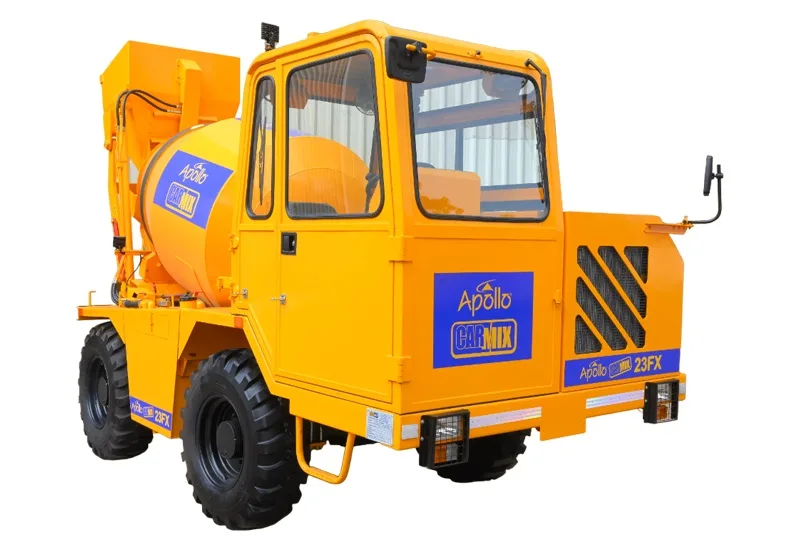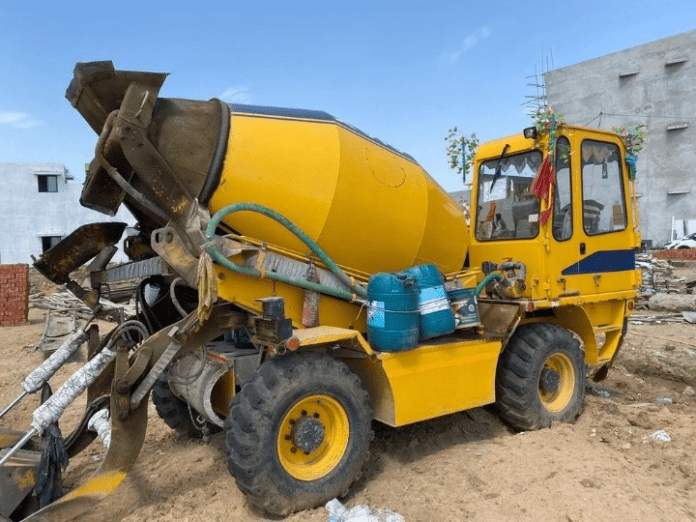A self-loading concrete mixer is a multifunctional construction machine designed to streamline the process of loading, mixing, and transporting concrete directly at the construction site. It features a rotating drum for thorough mixing and a hydraulic system for effortless loading of raw materials like aggregates, cement, and water. The machine ensures better quality control as users have direct oversight of the mixing process, resulting in consistent and high-quality concrete production. Equipped with four-wheel drive and steering, these mixers can maneuver across diverse terrains with ease, ensuring accessibility to even remote construction sites. Widely used in various construction projects ranging from buildings to roads and infrastructure, these machines are indispensable for modern construction practices, providing efficiency, versatility, and convenience on the job site.
Components of Self-Loading Concrete Mixer
The key components of a self-loading concrete mixer typically include:
1. Mixing Drum: The drum where the concrete ingredients are loaded, mixed, and transported. It rotates to ensure thorough mixing of the materials.
2. Loading System: This system includes a built-in bucket or conveyor mechanism for loading aggregates, sand, cement, and water into the mixing drum.
3. Control Panel: Allows the operator to control various functions of the mixer, such as loading, mixing, and dispensing concrete.
4. Chassis: The structural framework that supports the mixer and provides mobility. It is often mounted on a truck or trailer for easy transportation.
5. Engine: Provides the power necessary to operate the mixer, including powering the drum rotation, loading system, and mobility.
6. Water Tank: Stores water for mixing with the other ingredients to produce concrete.
7. Hydraulic System: Controls the movement of the loading bucket, drum rotation, and other functions of the mixer.
8. Discharge Chute: The opening through which the mixed concrete is discharged onto the desired location.
Advantages of Self-Loading Concrete Mixer Models
- Streamlines concrete production process
- Reduces labour and equipment costs
- Offers enhanced mobility between job sites
- Provides versatility in remote environments
- Produces fresh concrete on-site
- Allows customizable mixing
- Saves time and costs in construction projects
- Improves productivity and efficiency on construction sites
- Minimizes dependency on external concrete suppliers
- Reduces transportation costs by mixing concrete on-site
- Enhances control over concrete quality and consistency
- Increases flexibility in scheduling and project execution
- Reduces environmental impact by minimizing waste and emissions
- Enhances safety by reducing manual handling of materials
- Facilitates operation in tight or inaccessible spaces due to its compact design
- Offers convenience with integrated loading and mixing functions
- Allows for immediate adjustments to concrete mix based on project needs
- Supports continuous workflow with rapid mixing and dispensing capabilities
- Enhances project management with real-time monitoring of concrete production.
Types of Self-Loading Concrete Mixers
Rotating Drum Mixer:
A rotating drum mixer is a self-loading concrete mixer characterized by its drum, mounted on a chassis, where concrete ingredients are loaded, mixed, and discharged. Its operation begins with the loading of raw materials such as aggregates, sand, cement, and water, facilitated by a built-in bucket or conveyor system. Once loaded, the drum rotates continuously, ensuring thorough blending of the ingredients to produce homogeneous concrete. To discharge the concrete, the drum can be tilted, allowing for precise pouring at the desired location. These mixers are available in various capacities, catering to a wide range of construction projects, from small-scale residential endeavors to larger commercial ventures. Their versatility makes them suitable for applications like road construction, building projects, and infrastructure development.
Truck-mounted Mixer:
A truck-mounted mixer is a self-loading concrete mixer that integrates the mixing unit onto a truck chassis, offering enhanced mobility and versatility. The mixer is typically positioned at the rear of the truck, facilitating easy transportation between job sites. Featuring a built-in loading mechanism, such as a bucket or conveyor system, these mixers allow operators to load raw materials directly into the mixing unit. Controls for loading, mixing, and dispensing concrete are conveniently located in the driver’s cabin or on the mixer itself, enabling efficient operation. The truck-mounted design enables these mixers to navigate various terrains and access tight or confined spaces, making them ideal for urban construction projects. Available in different capacities, they cater to a wide range of project needs, from small-scale residential endeavors to large-scale infrastructure developments. Truck-mounted mixers streamline concrete production on-site, reducing dependency on external suppliers and transportation costs while enhancing project efficiency.
Different Self-Loading Concrete Mixer Models
Self-Loading Concrete Mixers with Controller System
This latest machine is capable of self-loading aggregates, weight batch, mix, transporting & delivering concrete within site. The Drum plays a vital role in the quality of the concrete as the mixing process happens inside the drum. The Dual helix spiral design blades with optimal width provide homogenous concrete mix & faster discharge of concrete. Also optimised blade width reduces the friction of the blades with the concrete, thereby reducing the overall maintenance cost. The drum lift feature ensures the faster discharge of concrete and reduces the cycle time which enhances thereby increasing the productivity & life of the machine. The smart Concrete Batch Controller (CBC) fitted in this machine ensures the right quantity of materials are fed into the drum by the operator and hence homogeneous concrete is assured.

Self-Loading Concrete Mixers with Hydrostatic Transmission and Drum Rotation
The latest concrete mixer has a capacity of 6100 litres with a mix yield of 4.5 m3, The mixers consist of double mixing screw and a drum with hydraulic motor rotation and planetary gearbox produces a homogeneous and compact mix. The hydraulic system of the mixers comprises three independent circuits. Two variable outlet pumps for hydrostatic transmission and drum rotation. It has a three-way steering system with a swivelable driver post with 180° for complete visibility during driving as well as complete visibility for loading side during weighing and batching, mixing and discharge operations. The mixer is equipped with an electronic weighing system complete with a printer to issue a mix certificate on the spot.

Self-Loading Concrete Mixers with Designed Blades for better mixing & faster discharge
The spiral design blades with optimal width provide concrete mix and faster discharge of concrete. The helix design can quickly discharge even zero slump concrete with the minimal residual matter in the drum. The use of special abrasion-resistant steel and edge protection on the blades gives the machine a longer life. The optimised blade width reduces the friction of the blades with the concrete, thereby reducing the overall maintenance cost. It also comes with a powered shovel gate for spillage-free charging. There are different modes of steering which enable the machine to work in different types of spaces.

Self-Loading Concrete Mixers with Telematics for Precision Batch output
Latest self-loading mixers cater to higher output requirements of Concrete batching, Mixing and Placing in the urban development Segment. It is fitted with the latest CEV Stage 4 Engine excellent fuel savings while adhering to the latest emission norms. The machine is also suited for tough terrain conditions and a boon for Contractors who have taken up smaller projects, where optimized equipment investment is important. Its features include – telematics ensuring precision in batch output, less mixing time improving the overall output, innovative Drum Design ensuring less wear and less maintenance, and ergonomically designed structure provides safety to man and machine.

Applications of Self-Loading Concrete Mixers
- Road Construction
- Building Construction
- Infrastructure Projects
- Remote or Rural Construction
- Repair and Maintenance Work
- Urban Construction Sites
- Landscaping and Hardscaping etc.
Why the demand in India?
With ongoing urbanization and infrastructure development projects across the country, there is a growing need for efficient concrete mixing and transportation equipment. Its demand is led by ;
- Rapid urbanization and construction boom drive demand.
- Government infrastructure projects boost market growth.
- Easy operation and versatility appeal to contractors.
- Quality control and environmental considerations influence adoption.
Conclusion
Self-loading concrete mixers have emerged as indispensable assets in the construction industry, offering a multitude of benefits and applications. From large-scale infrastructure projects to small-scale residential developments, self-loading concrete mixers have proven their worth in diverse construction settings. As urbanization continues and infrastructure demands grow, the demand for these innovative machines is expected to rise further. With ongoing advancements in technology and design, self-loading concrete mixers are poised to remain essential tools for meeting the evolving needs of the construction sector, driving progress, and facilitating sustainable development.
Image Source: ajax-engg.com, apollocarmix.com, conmatindia.com, schwingstetterindia.com

